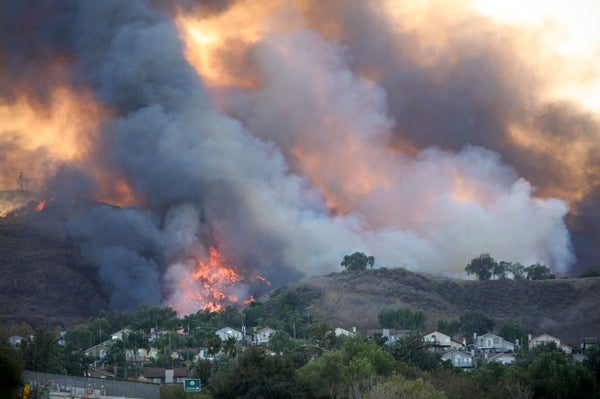Carbon pollution from California’s 2020 wildfires erased 16 years of the state’s greenhouse gas emission cuts, according to a new UCLA study.
The fires were the state’s most destructive on record, burning 4.2 million acres, killing dozens of people and destroying thousands of homes. The study—published in Environmental Pollution—adds another statistic: the fires released roughly 127 million metric tons of greenhouse gas emissions, or about twice California’s total emission cuts from 2003 to 2019.*
“What happened in 2020 was basically like a new sector; a new sector of emissions just came out of nowhere,” said study co-author Amir Jina, a University of Chicago professor. The wildfire emissions were “almost as big as their main emission sector, which is transport.”
On supporting science journalism
If you're enjoying this article, consider supporting our award-winning journalism by subscribing. By purchasing a subscription you are helping to ensure the future of impactful stories about the discoveries and ideas shaping our world today.
The Golden State sees itself as the nation’s leader in climate policy, launching a series of programs and regulations to cut emissions. That includes requirements that the electrical sector use only carbon-free energy by 2045 and car makers sell only zero-emission vehicles by 2035. The state also runs a carbon cap-and-trade market that forces large businesses to cut emissions or buy environmental permits for their pollution.
But California is simultaneously grappling with an increase in the ferocity of wildfires amid a changing climate. Scientists say record heat and drought make vegetation more flammable.
In addition, “more frequent and severe droughts,” are triggering conditions producing much larger wildfires, said LeRoy Westerling, a professor of management of complex systems at the University of California, Merced.
Researchers had predicted that climate change would bring wildfires twice as destructive as the historical average within 30 years. The 2020 wildfires made that prophecy come true decades early (Climatewire, Nov. 10, 2020).
The California Department of Forestry and Fire Protection described 2020 as a “fire siege,” with 18 of the state’s 20 most destructive fires on record. The emissions from those fires topped the 2019 emissions from the state’s electrical power generation and its industrial sector, Jina said.
But two experts not involved in the study emphasized that fossil fuel emissions and wildfire emissions are different.
While fossil fuel emissions stay in the atmosphere for thousands of years, most wildfire emissions are eventually reabsorbed by vegetation growth somewhere on the globe, said Michael Wara, director of Stanford University’s climate and energy program.
David Clegern, a spokesperson for the California Air Resources Board, also rejected that fossil fuel emission reductions are wiped out by wildfire emissions. Wildfires, when they occur in a healthy way, can bolster carbon sequestration rates and help preserve carbon stocks by germinating seeds, mobilizing nutrients, thinning overly dense forests and reducing risk of catastrophic wildfire, he said.
Jina said the study did not account for emissions that would be absorbed by any future regrowth of trees and vegetation that burned down in 2020. If those trees grow back over several decades, they could absorb the carbon released from the fires, he said. But that’s not guaranteed, he said, and in the meantime, those emissions will contribute to climate change.
To calculate the wildfire emissions, the UCLA researchers used data from two satellites and CARB. They used CARB data for the state’s emissions cuts.
Westerling, who was not involved in the study, said the analysis appeared accurate. But that doesn’t mean “we should just throw up our hands and say, ‘Oh, we can’t do anything,’” he said.
Instead, it signals the need for even deeper emissions cuts to ensure extreme wildfires and other climate impacts don’t get worse, he said. Otherwise, “we’re just opening ourselves up to greater and greater risk.”
CARB is currently considering a 2022 draft plan to achieve carbon neutrality by 2045. That plan includes projected greenhouse gas emissions from wildfires and carbon sequestration from lands, Clegern said.
Once the board adopts the plan, he said, it will begin including wildfire emissions “as an emission source that needs to be mitigated in our overall climate strategy to achieve carbon neutrality.”
Reprinted from E&E News with permission from POLITICO, LLC. Copyright 2022. E&E News provides essential news for energy and environment professionals.
*Editor’s Note (1/19/23): Our partners at Climatewire have revised this sentence after posting to correct the amount of emissions released from the 2020 wildfires.
